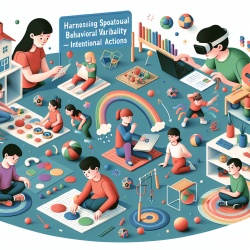At TinyEYE, we are committed to delivering the best online therapy services to schools. Our goal is to create meaningful and positive outcomes for children. A recent study titled Give spontaneity and self-discovery a chance in ASD: spontaneous peripheral limb variability as a proxy to evoke centrally driven intentional acts offers valuable insights into how practitioners can leverage spontaneous behavioral variability (SBV) to evoke intentional actions in children with autism spectrum disorder (ASD).
The study by Torres et al. (2013) emphasizes the potential of using SBV as a means to engage children with ASD in activities that lead to more intentional and goal-directed behaviors. The key takeaway is that children with ASD can self-discover goals and learn to prioritize them, leading to improved volitional control over their actions. This approach is particularly beneficial because it aligns with the natural tendencies of children to explore and learn through interaction with their environment.
Implementing SBV in Therapeutic Practice
To integrate the findings of this study into your practice, consider the following steps:
- Create an Interactive Environment: Design activities that allow children to explore their surroundings. Use tools and interfaces that provide immediate feedback based on their actions.
- Encourage Self-Discovery: Instead of giving explicit instructions, let children figure out the goals of tasks on their own. This approach can foster a sense of independence and self-motivation.
- Use Sensory Substitution: Incorporate visual and auditory stimuli to help children connect their actions with outcomes. This can enhance their understanding of cause-and-effect relationships.
- Monitor Progress with Data: Utilize data-driven methods to track the variability and predictability of children’s movements. This can help you assess their progress and adapt your strategies accordingly.
Encouraging Further Research
While the study provides a solid foundation, there is always room for further exploration. Practitioners are encouraged to conduct their own research to validate and expand upon these findings. By doing so, you can contribute to a growing body of knowledge that aims to improve therapeutic outcomes for children with ASD.
Here are some areas for potential research:
- Longitudinal Studies: Investigate the long-term effects of SBV-based interventions on children’s development.
- Comparative Studies: Compare the effectiveness of SBV-based interventions with traditional methods.
- Customization: Explore how individualized interventions based on SBV can be tailored to meet the unique needs of each child.
By embracing the principles outlined in the study and continuing to innovate, practitioners can make significant strides in helping children with ASD achieve greater autonomy and improved quality of life.
To read the original research paper, please follow this link: Give spontaneity and self-discovery a chance in ASD: spontaneous peripheral limb variability as a proxy to evoke centrally driven intentional acts.










